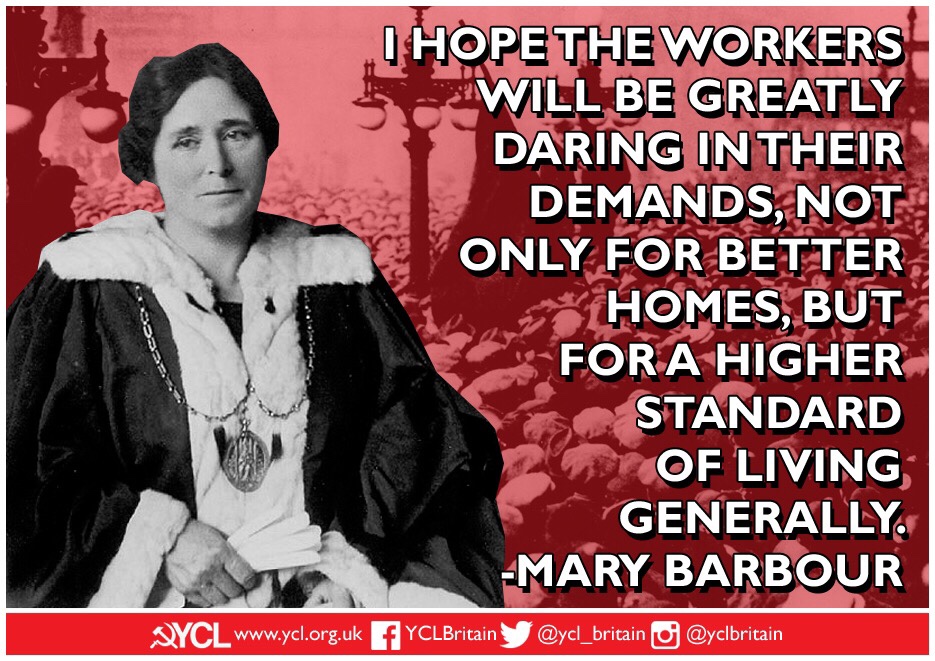 As part of a month long build up to International Women’s Day Celebrations on the 8th of March, the YCL will be publishing daily articles highlighting the exemplary role played by women in the international communist & working class movement.
As part of a month long build up to International Women’s Day Celebrations on the 8th of March, the YCL will be publishing daily articles highlighting the exemplary role played by women in the international communist & working class movement.
#25 Mary Barbour, leader of the 1915 Glasgow Rent Strikes, peace activist and tireless campaigner for working people
YCLers are encouraged to host, support and participate in celebrations locally to bring the message of International Women’s Day into our workplaces, colleges and schools, and communities.
Mary Barbour (1875-1958) was born on the 20th February 1875 in Kilbarchan before the family moved to Elderslie where she gained work as a thread twister and eventually becoming a carpet printer.
Barbour is best known for her political work during the Glasgow Rent Strikes of 1915. At its peak 20,000 tenants in Glasgow went on strike due to a near constant increase by landlords in the rent and other exploitative practices.
As the leader of the South Govan Women’s Housing Association she played a key role in all facets of the strike from organising the campaign to physically resisting attempted evictions. Because of the highly organised and militant nature of the strike it forced of the government of the time to freeze all rents at the pre war levels and to pass the Rent and Mortgage Interest Restriction Act 1915. This was a historic victory for the working class in Glasgow. The Rent Strikers are remembered to this day as “Mrs Barbour’s Army”.
In June 1916 Barbour, along with Helen Crawfurd (Communist Party) and Agnes Dollan, was a founder of the Women’s Peace Crusade (WPC) which campaigned for a negotiated settlement to bring an end to WWI. They organised through large open air meetings in Glasgow, Clydeside and Edinburgh, this came at a time of the Easter Rising and shortly before the Russian Revolution which brought a large focus of attention to the peace movement.
At the May Day celebrations in 1917, Glasgow Green drew a crowd of over 70,000. Mary Barbour along with other prominent womens peace activists were amongst the main speakers. The WPC continued to campaign vigorously up until the end of WWI.
After this Mary Barbour made a very welcome entrance into electoral politics and was elected to Glasgow Town Council in the Fairfield ward of Govan becoming one of the city’s first woman councillors. During her time in this role she worked tirelessly particularly within health and welfare provisions and continued this work past her retirement in 1931.
From 1925 she was the chair of the Glasgow Womens Welfare and Advisory Clinic which was the first centre of its kind to offer advice on birth control in Scotland and in November 1926 she attended the opening of the West Govan Child Welfare Clinic.
Such was Mary Barbour’s legacy she was remained a household name for many in Glasgow and indeed in Scotland up to the present day and there are many statues and plaques in her honour across the West Coast of Scotland.
Mary Barbour demonstrated that with militant and effective neighbourhood organisation significant victories can be won and class consciousness can be raised. Connecting the local struggles to the national and the international struggles, rents in Glasgow to slaughter on the Western Front, is a powerful lesson which can readily be applied today.